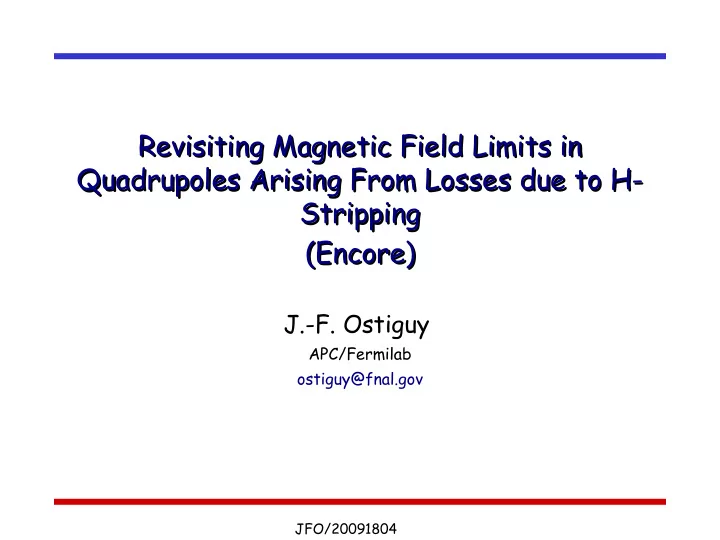

Revisiting Magnetic Field Limits in Revisiting Magnetic Field Limits in Quadrupoles Arising From Losses due to H- Quadrupoles Arising From Losses due to H- Stripping Stripping (Encore) (Encore) J.-F. Ostiguy APC/Fermilab ostiguy@fnal.gov JFO/20091804
H- Stripping: Theory and Phenomenology H- Stripping: Theory and Phenomenology ● H- moving through a magnetic field experiences a force that tends to pull p and e apart. In its rest frame, the ion experiences an E field. The “outer boundary” of the 1/r potential well is lowered, resulting in a finite tunneling probability. Accordingly, the ion lifetime τ in its rest frame can be parametrized (empirically) as follows: MV/cm [s MV/cm] MV/cm [s MV/cm ] MV/cm MV/cm Ref.: M.A. Furman in “Handbook of Accelerator Physics and Engineering” JFO/20091804
Lorentz's Boost Lorentz's Boost In the ion's rest frame, v' = 0 JFO/20091804
|E| in Ion Rest Frame For Specific Elements |E| in Ion Rest Frame For Specific Elements The decay time depends on the magnitude of the electric field in the ion's rest frame . Electric field in the ion's rest frame: Quadrupole : SW Cavity : JFO/20091804
Quadrupole Field Limit: How Conservative do we need to be ? Quadrupole Field Limit: How Conservative do we need to be ? From: : From P. Ostroumov, “Physics design of the 8 GeV H-minus linac”, New J. Of Phys., 8 (2006), p. 281 P. Ostroumov, “Physics design of the 8 GeV H-minus linac”, New J. Of Phys., 8 (2006), p. 281 “Tolerable magnetic field on the Danger Zone Danger Zone pole tip of quadrupoles” ● Tunneling parametric model, with parameters as specified previously ● Tolerable beam losses assumed to be 0.1W/m ● Quadrupoles assumed to occupy 10% of the focusing period length. ● Beam assumed uniformly distributed and occupying 70% of the aperture JFO/20091804
Comments Comments Ostroumov's assumptions for PD design are conservative. Beam occupies much less than 70% of aperture; as a consequence, |E r t | experienced by most e s particles gets overestimated. A uniform distribution may be pessimistic. Most particles are likely to be near the axis, further reducing the |E r t | experienced by most of them. e s Average beam current might be different (increased) in CW linac scenario: CW: 10 mA x 10% d.f. = 1.0 mA vs Pulsed: 45 (25) mA x 1 % d.f. = 0.45 (0.25) mA JFO/20091804
Probability of Particle Loss Probability of Particle Loss The electric field in the ion rest frame is related to the magnetic field in the lab frame as follows: The mean decay length in the lab frame is: where, again , The lost fraction f after a distance z is JFO/20091804
Loss Estimate Loss Estimate Fractional loss Lost fraction (depends on beam energy, E field in rest frame) Normalized (projected) bunch particle radial surface density Uniform with radius a Gaussian, with rms σ Quadrupole Length JFO/20091804
Allowable Fractional Beam Loss Allowable Fractional Beam Loss Duty factor, Bunch frequency particles/bunch Fractional loss For the Ostroumov baseline PD design, at Ek = 8 GeV one gets , for Ip = 25 mA If we assume an allowable power loss is < 0.1 W/m, then the allowable fractional loss per meter is To fix ideas, this translates into < 4 x 10 - 7 / m @ 1 GeV 5 x 10 - 8 /m @ 8 GeV JFO/20091804
Sample Calculation – Consistent with Ostroumov's Plot Sample Calculation – Consistent with Ostroumov's Plot Assumes a/Aperture = 0.70 Peak Current = 25 [mA] Duty Factor = 0.01 Average Current = 0.25 Ek = 1 [GeV] Average Beam Power = 0.25 [MW] gamma = 2.06724 Btip = 0.5 [T] Aperture = 0.03 [m] Decay length at beam edge [a, 3*sigma] = 134624 [m], 134624 [m] Decay probability at beam edge [a, 3*sigma] = 0.000707437, 3.53651e-05 Decay probability at beam edge [a, 3*sigma] = 0.021 0.021 Lost fraction [uniform, gaussian] = 5.39535e-07 3.78789e-08 Power loss in quad [uniform, gaussian] = 1.348837e-01 [W/m] 9.469719e-03 [W/m] Assumes σ=a/3, 3σ cutoff JFO/20091804
Not Surprisingly, Losses are Dominated by Tail Particles Not Surprisingly, Losses are Dominated by Tail Particles Peak Current = 25 [mA] Duty Factor = 0.01 Losses for Gaussian are 100 x higher Average Current = 0.25 Ek = 1 [GeV] if no cutoff in Gaussian distribution is assumed Average Beam Power = 0.25 [MW] gamma = 2.06724 Aperture = 0.03 [m] Btip = 0.5 [T] Decay length at beam edge [a, 3*sigma] = 134624 [m] 134624 [m] Decay probability at beam edge [a, 3*sigma] = 0.000707437 3.53651e-05 Decay probability at beam edge [a, 3*sigma] = 0.021 0.021 Lost fraction [uniform, gaussian] = 5.39535e-07 3.77615e-06 Power loss in quad [uniform, gaussian] = 1.348837e-01 [W/m] 9.440378e-01 [W/m] From previous slide, with 3σ cutoff: Lost fraction [uniform, gaussian] = 5.39535e-07 3.78789e-08 Power loss in quad [uniform, gaussian] = 1.348837e-01 [W/m] 9.469719e-03 [W/m] JFO/20091804
Beam Size (Ostroumov's PD Baseline) Beam Size (Ostroumov's PD Baseline) Actual beam size is much smaller than assumption used to generate 0.1 W/m limit plot A ~ 0.25 cm a (beam size) = 0.0025 [m] sigma_a (beam size) = 0.000833333 [m] Peak Current = 25 [mA] Duty Factor = 0.01 Average Current = 0.25 Ek = 1 [GeV] Average Beam Power = 0.25 [MW] gamma = 2.06724 Aperture = 0.03 [m] Btip = 0.5 [T] Decay length at beam edge [a, 3*sigma] = 1.346e+82 [m] 1.346e+82 [m] Decay probability at beam edge [a, 3*sigma] = 0 0 Decay probability at beam edge [a, 3*sigma] = 0.0025 0.0025 Lost fraction [uniform, gaussian] = 0 5.66354e-49 Power loss in quad [uniform, gaussian] = 0.000000e+00 [W/m] 1.415885e-43 [W/m] JFO/20091804
Power Loss Vs Pole Tip Field Power Loss Vs Pole Tip Field JFO/20091804
Conclusions Conclusions JFO/20091804
Recommend
More recommend